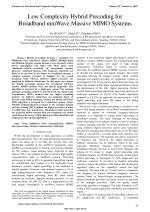| 4/2018 - 4 |
Low Complexity Hybrid Precoding for Broadband mmWave Massive MIMO SystemsHUANG, Y. |
| Extra paper information in |
| Click to see author's profile in |
| Download PDF |
Author keywords
millimeter wave communication, MIMO, signal processing, wireless communication, wideband
References keywords
wave(10), precoding(10), millimeter(10), hybrid(10), communications(10), systems(8), signal(6), processing(6), mimo(6), heath(6)
Blue keywords are present in both the references section and the paper title.
About this article
Date of Publication: 2018-11-30
Volume 18, Issue 4, Year 2018, On page(s): 35 - 42
ISSN: 1582-7445, e-ISSN: 1844-7600
Digital Object Identifier: 10.4316/AECE.2018.04004
Web of Science Accession Number: 000451843400004
SCOPUS ID: 85058804615
Abstract
Hybrid precoding becomes a candidate for Millimeter wave (mmWave) massive MIMO (Multiple-Input and Multiple-Output) systems because it can extremely reduce power consumption and high costs. Most prior work considered hybrid precoding for narrowband systems. However, wideband systems with frequency selectivity are likely to be operated in the future. In broadband systems, a common analogue precoder is designed for the overall frequency band whereas different digital precoders are employed in different subcarriers. In this paper, we propose the hybrid precoding schemes for broadband mmWave massive MIMO systems. First, the hybrid single-user (SU) algorithm is proposed for a single-user system. The common analogue precoding matrix is derived from the Equal Gain Transmission (EGT) method and the digital precoding matrices for different subcarriers are employed based on directly water-filling technique. Second, the hybrid multi-user (MU) algorithm is proposed for a multi-user system. Gram-Schmidt orthogonalization is added in the analogue domain and zero-forcing (ZF) is utilized for digital precoders in order to nullify inter-user interference. Simulation results show that our proposed hybrid schemes with low complexity can almost reach the performance of fully digital precoding algorithm and outperform other hybrid algorithms. |
| References | | | Cited By |
Web of Science® Times Cited: 0
View record in Web of Science® [View]
View Related Records® [View]
Updated 3 weeks, 5 days ago
SCOPUS® Times Cited: 1
View record in SCOPUS® [Free preview]
View citations in SCOPUS® [Free preview]
There are no citing papers in the CrossRef Cited-by Linking system.
Disclaimer: All information displayed above was retrieved by using remote connections to respective databases. For the best user experience, we update all data by using background processes, and use caches in order to reduce the load on the servers we retrieve the information from. As we have no control on the availability of the database servers and sometimes the Internet connectivity may be affected, we do not guarantee the information is correct or complete. For the most accurate data, please always consult the database sites directly. Some external links require authentication or an institutional subscription.
Web of Science® is a registered trademark of Clarivate Analytics, Scopus® is a registered trademark of Elsevier B.V., other product names, company names, brand names, trademarks and logos are the property of their respective owners.
Faculty of Electrical Engineering and Computer Science
Stefan cel Mare University of Suceava, Romania
All rights reserved: Advances in Electrical and Computer Engineering is a registered trademark of the Stefan cel Mare University of Suceava. No part of this publication may be reproduced, stored in a retrieval system, photocopied, recorded or archived, without the written permission from the Editor. When authors submit their papers for publication, they agree that the copyright for their article be transferred to the Faculty of Electrical Engineering and Computer Science, Stefan cel Mare University of Suceava, Romania, if and only if the articles are accepted for publication. The copyright covers the exclusive rights to reproduce and distribute the article, including reprints and translations.
Permission for other use: The copyright owner's consent does not extend to copying for general distribution, for promotion, for creating new works, or for resale. Specific written permission must be obtained from the Editor for such copying. Direct linking to files hosted on this website is strictly prohibited.
Disclaimer: Whilst every effort is made by the publishers and editorial board to see that no inaccurate or misleading data, opinions or statements appear in this journal, they wish to make it clear that all information and opinions formulated in the articles, as well as linguistic accuracy, are the sole responsibility of the author.



